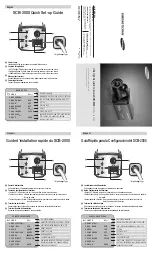
Page
2
of
7
ISO
9001:2015
Certified
Doc.
No.
06
‐
916
●
Rev.
1
4.
USB
to
RS
‐
485
Converter
Wiring
The
FIK
‐
USB/RS485
converter
easily
lets
you
connect
the
RS
‐
485
cable
directly
to
the
host
PC’s
USB
port.
Utilize
the
following
diagram
to
connect
the
RS
‐
485
wire
to
the
converter.
Figure
3:
USB
to
RS
‐
485
Converter
5.
Flame
Detector
Terminal
Block
Wiring
Each
flame
detector
is
equipped
with
a
20
‐
pin
terminal
block
that
allows
the
connection
of
field
wiring.
The
function
of
each
terminal
block
connection
will
vary
depending
upon
whether
the
detector
is
capable
of
providing
a
video
output,
as
shown
in
the
following
tables.
Table
1:
Wiring
connections
to
detectors
without
video
output
Pin
#
Function
Description
Ground
Ground
(earth)
Connected
to
a
screw
on
the
housing
exterior
1
24
VDC
(+)
Power
supply
(18
‐
32
VDC)
2
24
VDC
(
‐
)
Power
supply
return
(0
VDC)
3
0
‐
20mA+
(in)
0
‐
20
mA
analog
current
ouput
4
0
‐
20mA
‐
(out)
5
Fault
Relay
Normally
open
SPST
relay,
energized
(closed)
when
the
detector
is
in
regular
operation
and
opens
in
case
of
a
fault.
6
Fault
Relay
(COM)
7
Alarm
Relay
(NO)
Normally
open
SPST
relay,
open
in
regular
operation
and
closed
when
a
fire
is
detected.
8
Alarm
Relay
(COM)
11
24
VDC
(+)
Power
supply
(18
‐
32
VDC)
12
24
VDC
(
‐
)
Power
supply
return
(0
VDC)
13
Manual
BIT
activation
Manual
built
‐
in
‐
test
that
is
initiated
by
a
momentary
short
across
this
terminal
and
one
of
the
24
VDC
(
‐
)
terminals.
14
Shield
Permanent
connection
to
detector
housing
internal
ground.
15
RS485
(+)
RS485
Modbus
communication
(FGD
Communicator
software)
16
RS485
(
‐
)
17
Fault
Relay
(NC)
18
Alarm
Relay
(NC)
Note:
Highlighted
pins
indicate
required
connections.

























